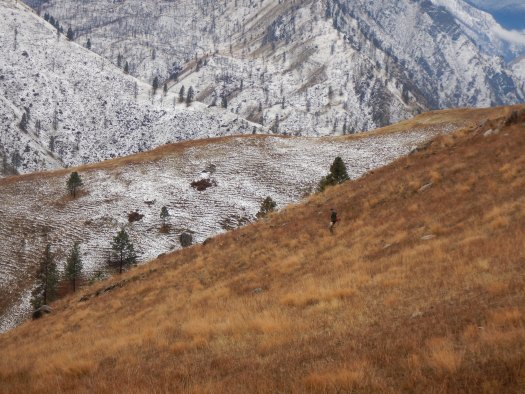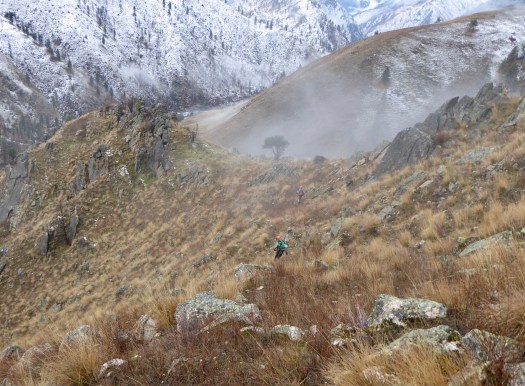A big part of the appeal of chukar hunting for most of us is the beautiful places where these wild birds live. These captivating and lonely places are hard to get to, and they challenge us mentally and physically, but they continue to seduce us to them year after year.
We daydream about the solitude and the spirit of these kinds of places when we’re not there, and we long for the slippery snow underneath our boots, the loose scree, the damp fog coming up from the valley floor, the sight of a dog pointing and retrieving, and, especially, the intoxicating views from the top of these sacred mountains.
I can’t wait to go back.




















I can not tell you how jealous I am!
The weather forecast was terrible for the weekend and the main highway to get halfway to this spot slick. We almost turned around.
It was truly God’s country. Thanks for reading. Leslie
Go for it while you can. It won’t last forever.
Sam you’re right. The hunt on Saturday was the first time in 10 years that I was actually scared of falling off of a mountain while chukar hunting. We ended up on this steep icy slope where every step I was slipping. I ended up crawling on my hands and knees. At the time, I was thinking “Why in the heck am I doing this!?” I’m over it now and look forward to going back.
Have a Merry Christmas Sam. Hugs to Hannah and Susie.
Laughing at “Why the heck am I doing this!?” Me a lot of the times.
Ben, those dogs made us do it…I’m sure! I’m blaming them this time (again) and I’m fairly certain that I used some other choice words instead of heck but I’m trying to clean up my act…even at my advanced age.
Merry Christmas to you. Leslie
Grateful we live in such awesome country and have the ability to get out and enjoy it.
Great work, love your stories and photographs.
Yes, grateful for all the public lands we have out here in the West and thankful that our bodies are allowing us to do this year after year after year.
Thank you for your nice comment Greg and for also for reading our blog. Cheers, Leslie and Bob
As you know, I try to figure out where you and Bob are hunting from the background in your photos. This post took a bit of thinking. Obviously hunting a south facing slope with the river flowing north with no road. Believe I got it but will have to wait for confirmation till next fall.
It would be interesting to know how many miles you and Bob each walk during the entire season pursuing chukars and the miles walked per bird harvested. I estimated two miles per chukar in the vest while in Idaho during October.
I just read your comment to Bob and now he’s adding a new column to his chukar hunting stats spreadsheet on the computer. Elevation per bird in addition to miles per bird. He’ll let you know his results at the end of the season. As for me, my stats, place hunted, distance, time, and elevation are scribbled on a piece of paper. I don’t track birds in the bag. I suppose that I should start doing that.
Come next fall, we’ll tell you our secret spot. 😉
Cliff, I never thought about the miles-per-bird stat, so I took a look, and added “elevation gain per bird” just for kicks. Two years ago, I averaged 3.4 miles per bird and 1,100 feet of climbing. Same last year, almost to the decimal (although I hunted way less because of my back). This year so far, it’s 2.5 miles and 700′ per bird. I included all species. Not sure what the “improvement” means or what to attribute it to, but I’ll take it.
Bob, I stopped keeping track last year but since the astro came out I use to keep track of all those things. Birds per hour, birds per mile, birds per dog miles, my elevation per bird, shooting percentage, # of lost birds per year, Number of points that flushed before I got to them compared to the number of points I got to flush, weather conditions and too much more. One year I even kept track of cost and money per bird. I quickly through those notes away.
Perfect description and pictures of chukar country. I covered 7 1/2 miles yesterday in country very similar. The only sounds I heard were the flushing birds, the report of my shotgun and an occasional rock bounding down the steep slope. At the end of the day my ankles and back hurt so bad I wondered when I would have to say no more. But this morning as the dogs and I watch the rain falling we can’t wait to get at it again.
Damn Larry, that’s a long hunt. Your description sounds like our day. Rock scrambling, rocks falling, the sound of a covey busting wild around the corner before you could get there. Lots of fun. Pain is only temporary.
The weather looks good for today and this weekend. Have a great hunt.
Merry Christmas! Leslie and Bob.
Ah, the elevation gain per bird!! That separates the real chukar hunter from the rest. We’ve had bird hunting friends who could literally walk from dawn to dark on less challenging terrain but a day or two chasing the red legs left them with feet of the same color and asking about quail on flat ground.
MERRY CHRISTMAS TO ALL
Living in Texas I don’t get to hunt Idaho chukar but 3 weeks a year so I am a rookie. After greenup do you always make the climb to the top to find most birds or not necessarily. I find that if it takes me 2 hours to get to the top I am burning up too much energy and losing dog power. So Prefer to keep the climbing to an hour to get to the top. Am I missing out on better bird numbers?
Kelly, it depends on the terrain, weather, habitat. I’d say there’s no rule. Usually when I notice, while hiking, that the amount of greenup changes and gets heavy I start finding birds. Notice I say “usually.” Yesterday we took 2.5 hours to get to the top, didn’t see a bird on the way, and when we summited it got real. I try to balance where I want to go with what the dogs are doing. They usually know way better than we do where to focus our attention. It’s a learning game that never ends. I think that’s why I like it.